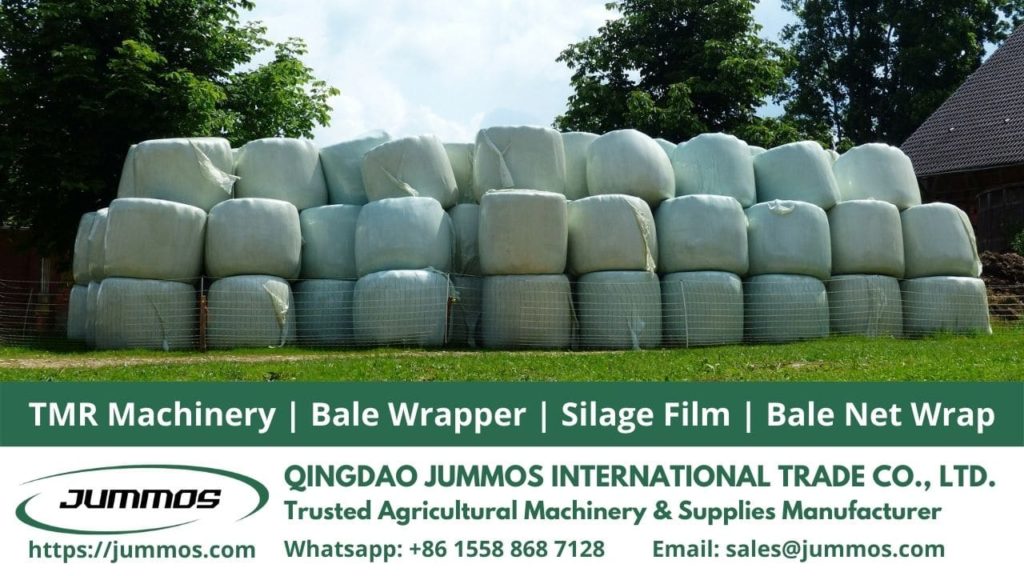
How to stack silage, or rather the silage bales will affect the amount of waste produced. Good stacking also prevents damage to the feed, while ensuring security and safety. We do supply front loading bale clipper to help you stack silages. Furthermore, check out this article for a guide to stacking silage bales safely and correctly.
Contents
How to Stack Silage Bales
Silage is a process of preserving animal feed through fermentation with the help of microorganisms and high-water content. The process is carried out under airtight conditions (anaerobic or without oxygen), sometimes with the addition of preservatives.
Meanwhile, a silage bale is an agricultural tool used to store livestock feed reserves in the form of silage. Bales need to be handled properly so that the silage lasts longer and does not lose the nutrients it contains. The trick is to choose the best bales, use other supporting tools such as quality bale wrappers, and equally importantly, pay attention to safe and correct bale stacking. Here is the general guide to stacking silage bales.
Stacking Position and Method
Round bale has two sides, a curved side and two flat sides at the end. If the storage space tends to be large, large circular bales with closed ends should not be stacked, but stored in an upright position (flat end side down). However, for a limited space, only stack bales that have the same diameter if they are standing.
Then, unwilted bales should not be stacked and placed on the ground (both sides are allowed). whereas a successfully wilted bale can be stacked in 2-3 piles but only on the curved side.
The safest way to stack round bales is to use the ‘pyramid stack’ method, which is to stack bales on the curved side to form a pyramid. For this method, especially if the bales are very dense (wilted hay), the underlay on the outside of each bale should use a wedge or similar support. The wedges prevent the bales from moving and assist in safe unloading.
Stack Height
The pile height should be adjusted to the dry matter (DM) in the silage bale. Bales filled with lush grass should not be stacked at all. Soft or not too-dense bales (unwilted hay) with DM of 25-35 percent in packed silage may be stacked up to two layers high, and 3-4 layers high if DM exceeds 35 percent.
Then, bales with DM below 25 percent are usually heavier and should not be stacked because they could compress the bales underneath, making the bales unstable or stretching the film. Specifically for the pyramid method, it is recommended that the maximum bale height is 4 layers and with additional supports to keep it safe.
How stack silage bales in a standing position can provide extra protection as the flat edges have more layers, but they should not be too high as the bales tend to become less stable. As an exception, stacking round bales in a standing position is not recommended because the varying density of feed material in the bales causes the bales to shift.
Practical Height Calculation
Apart from the safe access restrictions described above, the most practical way how to stack silage is to ensure that the height of the bales does not reach 1.5 times the dimension of the shortest bed.
For example, a farm has 12 large bales ready for storage. In the lowest layer, 10 squares with a length of 12.5 meters and 2 boxes with a width of 5 meters are lined up. Then the safe height that can be achieved is by multiplying the shortest base (width of bale space) with dimensions of 1.5 or 5 m x 1.5 = 7.5 m. That is, the safe height of bale piles is equal to or less than 7.5 meters.
Time and Duration of Accumulation
The packed silage bales must be stacked within 24 hours at the latest. After that, don’t touch or change the stack for at least three weeks.
Pest Protection
To avoid pest attacks, use bait such as net wrap placed in the area around the pile, not on the inside of the pile. In addition, make sure the piles of bales are far enough from livestock.
How to Store Bale Silage
Apart from stacking, knowing how to store the silage bales safely and correctly is also necessary. Here are some things to know.
- Store round bales on a flat surface, especially if they are stacked.
- Store the bale in a dry and protected place, preferably in a room or bunker.
- Avoid hanging bales from trees.
- Storage of silage bales must be at least 10 meters from ditches, drains, drains, and other water sources.
- Silage bales must be kept away from power lines.
- Make sure that all open ends of the bales are tightly closed so that the quality of the silage is maintained.
- Inspect the bales for damage regularly and regularly.
- Always put safety first when implementing how to stack silage because the bales can shift and move over time, even if they are freshly wrapped or appear structurally secure.
- Keep the silage bales out of reach of children.
That’s an article about how to stack silage correctly and safely. Hopefully this information can be useful for you.

